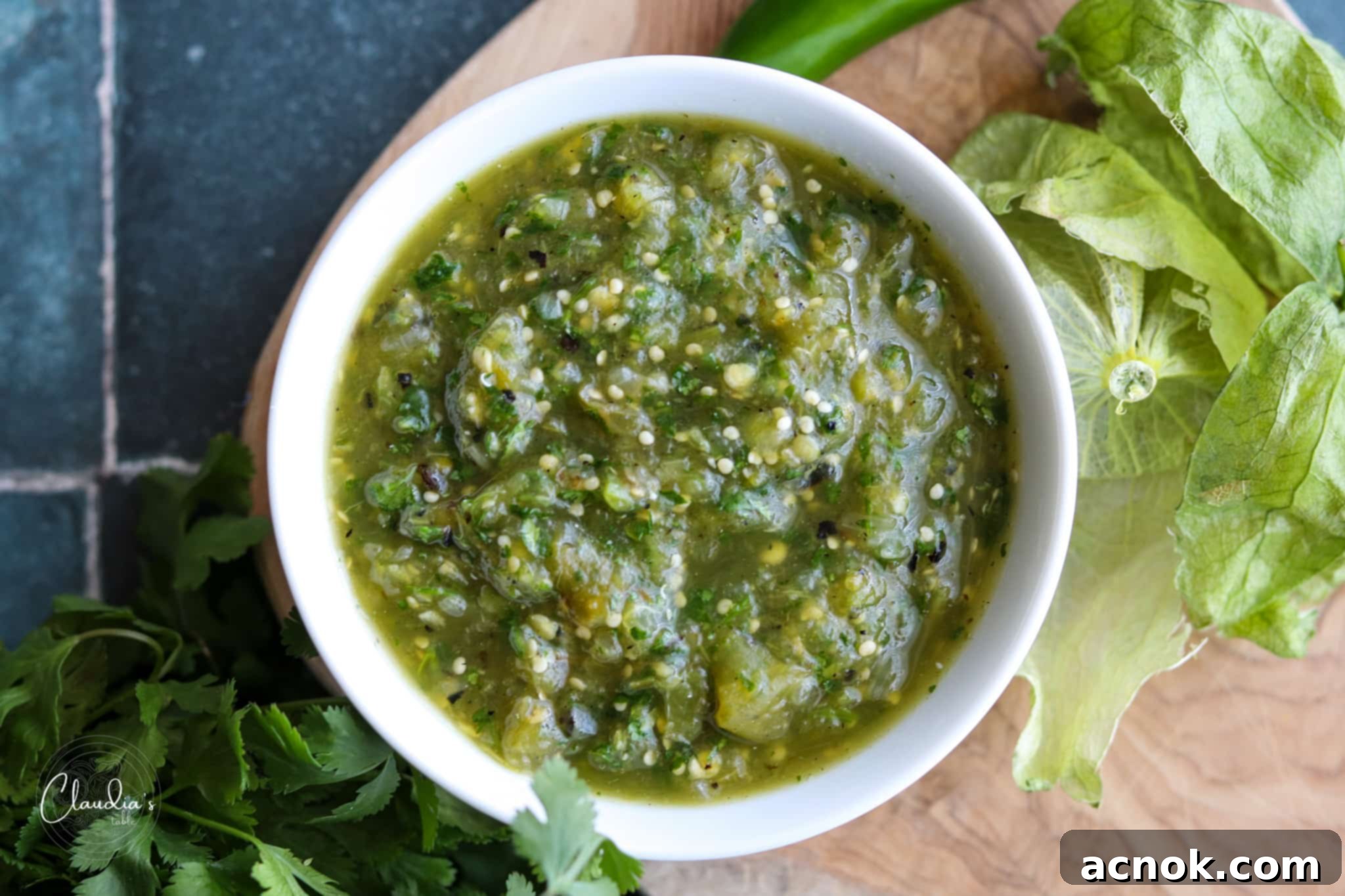Authentic Roasted Tomatillo Salsa Verde: Your Guide to Tangy, Smoky Mexican Flavor
Prepare to elevate your Mexican cooking with this incredible **Roasted Tomatillo Salsa Verde**. Far from a simple condiment, this salsa is a cornerstone of Mexican cuisine, celebrated for its vibrant flavors and incredible versatility. Its signature tanginess from the tomatillos, coupled with a deep, smoky undertone from roasting, and a customizable kick from Serrano or Jalapeño chiles, makes it an absolute favorite. While many methods exist for crafting salsa verde—from raw to boiled—the roasted approach unlocks a depth of flavor that is truly unparalleled. It transforms humble ingredients into a rich, complex sauce that complements almost any dish.
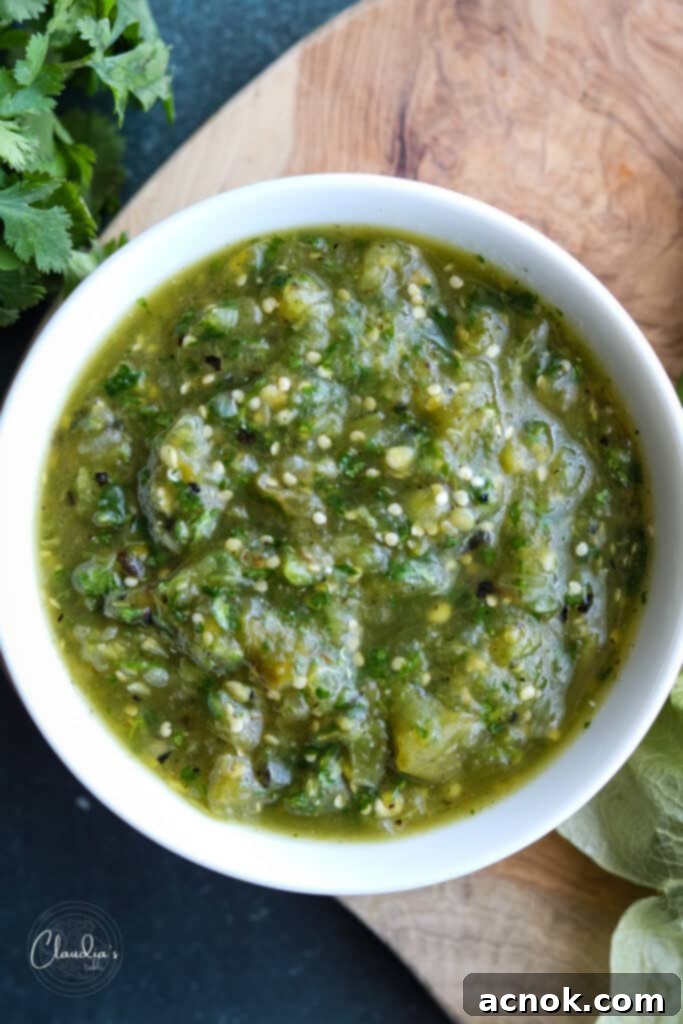
Table of Contents
- The Versatility of Mexican Salsa Verde
- Understanding Tomatillos: Mexican Husk Tomatoes
- Salsa Verde vs. Tomatillo Salsa: What’s the Distinction?
- Essential Ingredients for Your Roasted Salsa Verde
- Step-by-Step: How to Make Roasted Tomatillo Salsa Verde
- Serving Suggestions for Roasted Tomatillo Salsa Verde
- Storing and Make-Ahead Tips
- Frequently Asked Questions About Salsa Verde
- Explore More Delicious Recipes
The Versatility of Mexican Salsa Verde
Mexican cuisine is rich with an array of vibrant salsas, and Salsa Verde stands out as one of the most adaptable and beloved. While often enjoyed for its typically mild yet incredibly flavorful profile, its true magic lies in the method of preparation. It’s an absolute game-changer for dishes like Spicy Shrimp Tacos, delightful with Fish Tacos, essential for succulent Carnitas, a key ingredient in Easy Salsa Verde Chicken and Rice, and perfect for a traditional Mexican Salpicón de Res. The roasted flavors in this particular version beautifully enhance these foods, adding a layer of complexity that raw or boiled methods simply can’t achieve. But did you know this dynamic salsa can be prepared in a few distinct ways, each yielding a unique flavor profile?
Beyond roasting, you can prepare salsa verde raw, which results in a super vibrant, fresh, and crisp salsa with a sharp, tangy bite—perfect for a quick snack or lighter dishes. Alternatively, boiling the ingredients creates a different, often milder, flavor, making it an excellent choice for stews like Chile Verde, where the salsa melds seamlessly into a hearty sauce. However, for a truly remarkable depth and an irresistible smoky element, roasting is the undisputed champion. This method caramelizes the natural sugars in the tomatillos and onions, while charring the chiles, infusing the salsa with an earthy, complex, and intensely savory taste that we absolutely adore.
Roasted Tomatillo Salsa Verde with Avocado
For an extra delicious and creamy variation, pulse 1 small peeled avocado and the juice of half a lime with the finished salsa verde ingredients. This creates a beautifully rich and smooth salsa, perfect for topping fish tacos, Spicy Shrimp Tacos, or grilled chicken.
Understanding Tomatillos: Mexican Husk Tomatoes
Often mistaken for green tomatoes, tomatillos (Physalis philadelphica) are actually a distinct fruit, though they belong to the same nightshade family as tomatoes. That, however, is where most of their similarities end. These bright green gems are easily recognized by their unique, paper-thin husks that encase the fruit. Peeling back the husk reveals an almost waxy, slightly tacky exterior on the tomatillo itself.
In terms of flavor, tomatillos are delightfully tart, sharp, and possess a distinct sourness that provides the essential backbone for salsa verde. They are native to Mexico, with a culinary history stretching back to the pre-Columbian era, deeply embedded in indigenous diets long before the arrival of Europeans. This ancient fruit is not only delicious but also offers some nutritional benefits, being a good source of Vitamin C, Vitamin K, and dietary fiber.
Where to Find and How to Choose Tomatillos
You can typically find fresh tomatillos in most Latin grocery stores, as well as in the produce sections of larger supermarkets, especially during peak season. When selecting them, look for firm, bright green tomatillos with tight-fitting husks. Avoid any that are soft, shriveled, or have damaged husks. The husks should be light brown and dry, not damp or moldy. Once home, store unwashed tomatillos in their husks in a paper bag in the refrigerator for up to two to three weeks. If you can’t find fresh tomatillos, canned whole tomatillos are a viable alternative for the salsa, though it’s important to remember they are already cooked and cannot be roasted, which means you’ll miss out on that signature smoky, charred flavor.
Salsa Verde vs. Tomatillo Salsa: What’s the Distinction?
The short answer is: they are essentially the same. The term “Salsa Verde” literally translates to “green sauce” in Spanish, and in Mexican cuisine, this green hue almost exclusively comes from the use of tomatillos. Therefore, when you hear “Salsa Verde” in a Mexican context, it inherently implies a tomatillo-based salsa. While the specific types of chile peppers (Serrano, Jalapeño, sometimes poblano for milder flavor) and other aromatics might vary slightly from region to region or even from family recipe to family recipe, the foundational components remain consistent: tomatillos, chiles, onion, garlic, and cilantro. So, whether you call it Salsa Verde or Tomatillo Salsa, you’re referring to the same beloved, tangy, and fresh green sauce that brightens countless Mexican dishes.
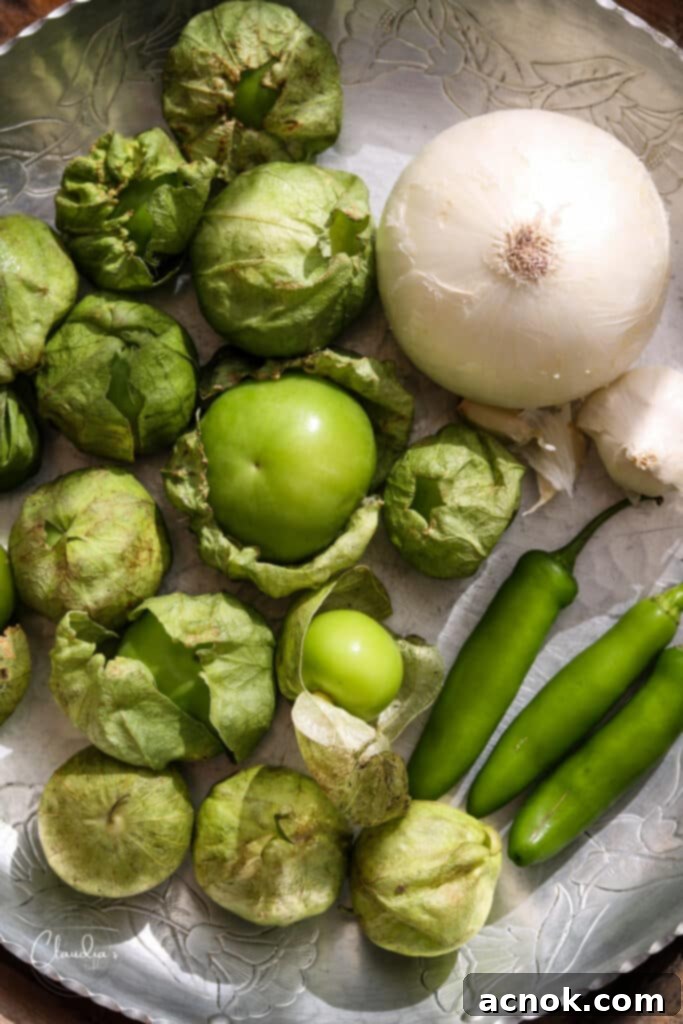
Essential Ingredients for Your Roasted Tomatillo Salsa Verde
Crafting this incredible Roasted Tomatillo Salsa Verde is surprisingly simple, and it will quickly become one of your go-to recipes. The beauty lies in a concise list of fresh ingredients that, when roasted, unlock an explosion of flavor. Quality ingredients are key here, so try to source the freshest possible produce for the best results.
- 6 raw tomatillos: The star of our salsa. Ensure husks are removed, and they are thoroughly washed and dried before roasting. Their natural tartness is essential.
- 1/4 of a small white onion: Peeled and cut into a wedge. Roasting the onion brings out its sweetness and adds a crucial aromatic depth to the salsa.
- 2 garlic cloves: Peeled. Fresh garlic provides a pungent base that mellows and becomes more complex during roasting.
- 1 cup of fresh cilantro: Washed and dried. Added at the end, fresh cilantro brightens the salsa with its distinct herbal, citrusy notes.
- 1-3 Serrano or Jalapeño chiles: Stems removed. These provide the heat! Use Serrano for a sharper, more intense spice, or Jalapeño for a milder, more rounded heat. For a less spicy salsa, you can remove the seeds and membranes from the chiles before roasting, as this is where most of the capsaicin (heat) resides. Adjust the quantity to your preferred spice level.
- Olive oil or canola spray: A light coating helps the vegetables char beautifully without sticking.
- Salt: To taste. Essential for balancing and enhancing all the flavors.
Remember, while the core ingredients are simple, their quality and the roasting process are what truly make this salsa shine. Don’t be afraid to adjust the chile count to suit your family’s palate!
Step-by-Step: How to Make Roasted Tomatillo Salsa Verde
The roasting process is what sets this salsa apart, infusing it with an irresistible smoky depth. While a cast iron pan on the stovetop is my preferred method for its even heat and excellent charring capabilities, you can also achieve fantastic results using your oven.
Stovetop Roasting Method (Recommended)
Using a cast iron pan allows for great control over the charring process, giving your salsa that signature smoky flavor. Make sure your kitchen is well-ventilated, as roasting chiles can release pungent aromas.
- Lightly spray your cast iron pan with a thin coating of olive oil or canola spray. You don’t need much; just enough to prevent sticking and aid in charring.
- Place the cast iron pan over medium heat on your stove. Allow it to heat up for a few minutes until it’s good and hot.
- Carefully add the prepared tomatillos, the onion wedge, and the whole chiles (Serrano or Jalapeño) to the hot pan. You will soon begin to see the ingredients charring, developing beautiful dark spots, and you’ll smell the wonderful aroma of roasting chiles filling the air. This charring is essential for the smoky flavor. Continue to rotate them every few minutes using tongs, ensuring all sides get evenly roasted.
- Keep roasting until the tomatillos, onions, and chiles are par-cooked. They should be tender, with significant charred spots, but not completely mushy. The tomatillos will soften and turn a duller green, the onion will be translucent with browned edges, and the chiles will have some blistering. This usually takes about 15-20 minutes.
- Once roasted to perfection, remove all ingredients from the heat source and the pan. Set them aside to cool slightly before processing.
Oven Roasting Method (Alternative)
If you prefer using your oven, preheat it to 400°F (200°C). Toss the tomatillos, onion, and chiles with a tablespoon of olive oil on a baking sheet. Roast for 20-25 minutes, flipping halfway through, until they are softened and nicely charred. Garlic can be added for the last 10 minutes to prevent burning.
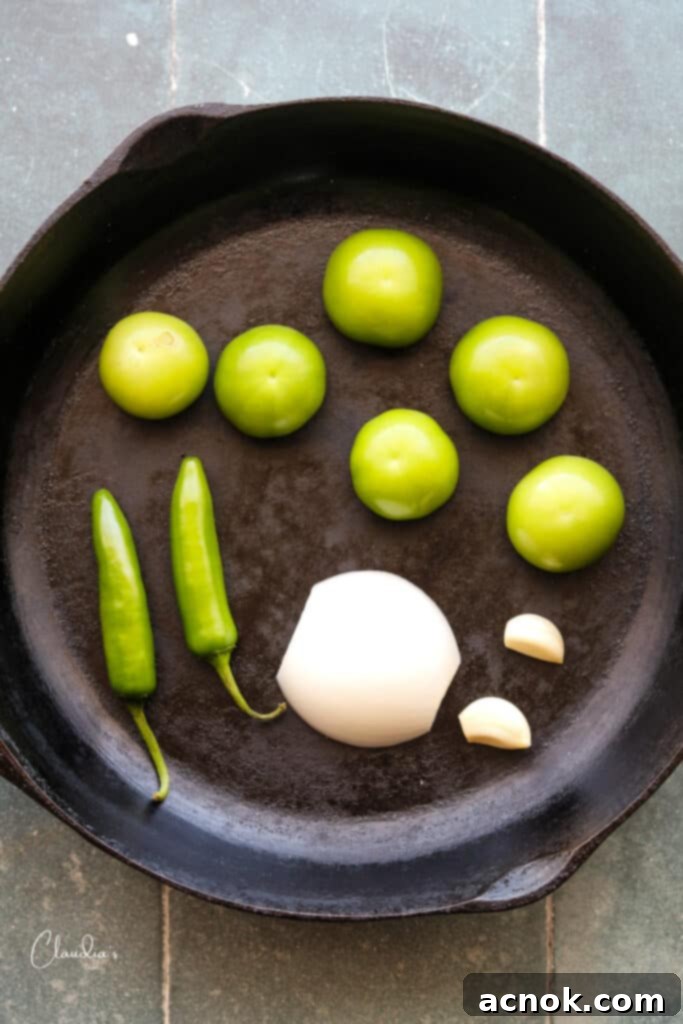
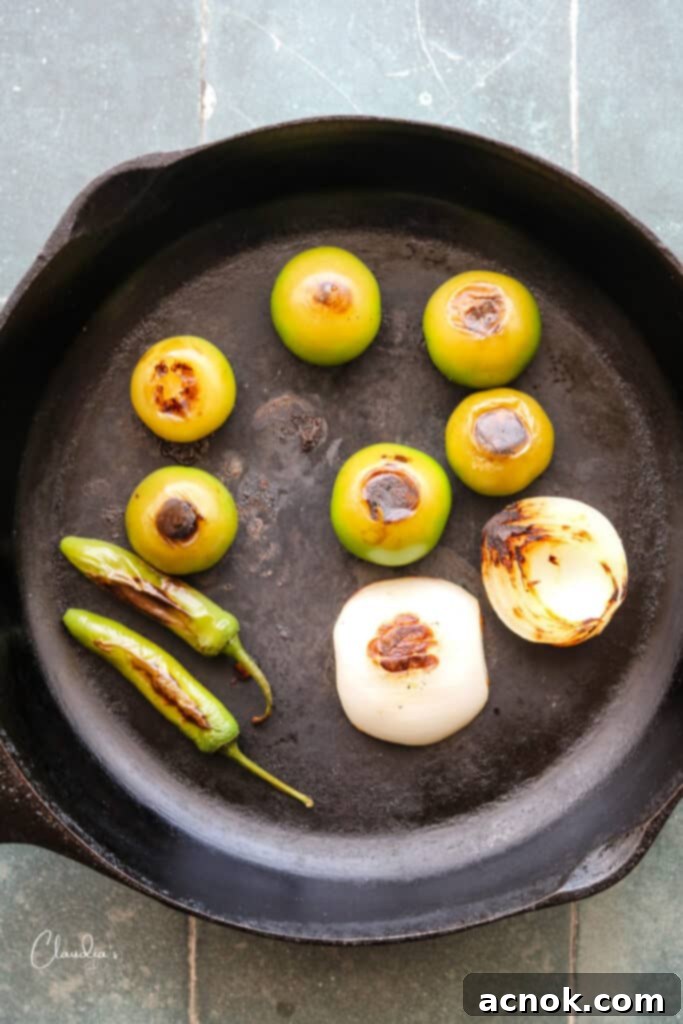
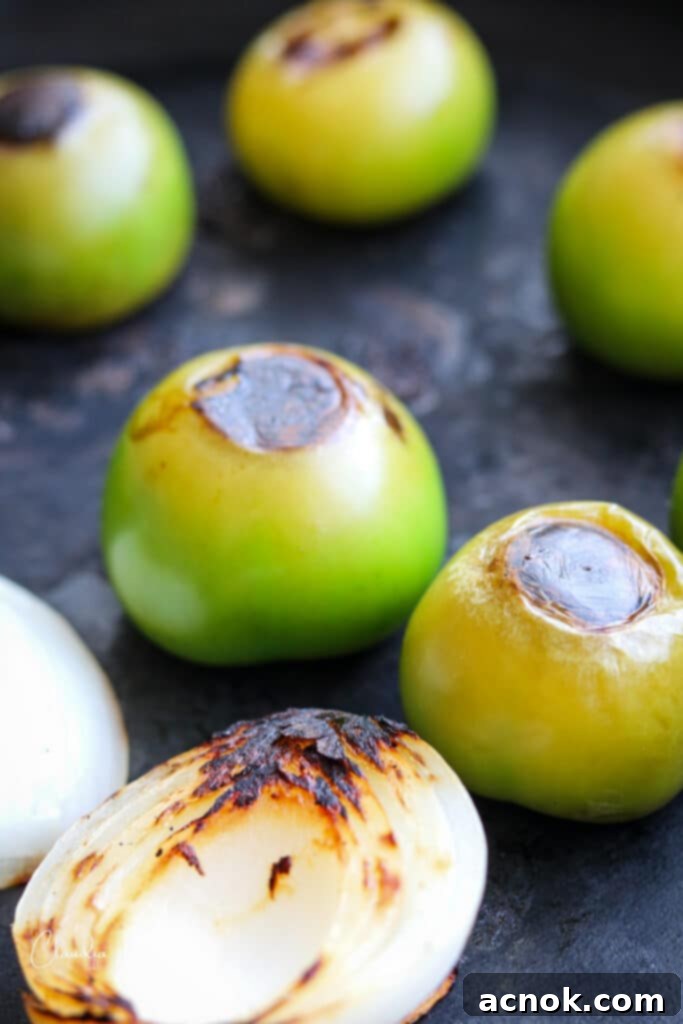
Blending the Salsa
Once your roasted vegetables have cooled slightly, it’s time to bring your salsa together. This step is quick and simple, but attention to texture is key.
- Carefully transfer the roasted tomatillos, onion, and Serrano chiles (with stems removed) into a food processor or blender.
- Add the fresh cilantro and the peeled fresh garlic cloves.
- Pulse the mixture until the salsa reaches a slightly chunky consistency. Avoid over-blending, as you want some texture, not a completely smooth puree. A few quick pulses are usually enough.
- Taste the salsa and add salt as needed. If you desire a thinner consistency, you can add a tablespoon or two of water or even a splash of chicken broth while pulsing.
And just like that, your homemade Roasted Tomatillo Salsa Verde is ready! Its rich, tangy, and smoky flavors will instantly elevate any dish.
Serving Suggestions for Roasted Tomatillo Salsa Verde
The beauty of Roasted Tomatillo Salsa Verde lies in its incredible versatility. It’s not just a dip for chips; it’s a foundational flavor that can transform many meals. Here are some of our favorite ways to enjoy this vibrant green sauce:
- **Classic Accompaniment:** Serve it alongside a basket of warm tortilla chips for an irresistible snack or appetizer.
- **Taco Night Essential:** It’s the perfect topping for all types of tacos, from Spicy Shrimp Tacos to carnitas, fish, or chicken tacos.
- **Enchilada Sauce:** Use it as a flavorful sauce for chicken or cheese enchiladas. Simply warm it through, pour over your rolled tortillas, and bake with a sprinkle of cheese.
- **Burritos and Bowls:** Drizzle it generously over burritos, burrito bowls, or grain bowls for an instant burst of flavor.
- **Breakfast Staple:** A must-have for Mexican breakfast dishes like Huevos Rancheros, Chilaquiles, or scrambled eggs.
- **Marinade Magic:** Its tangy and slightly acidic profile makes it an excellent marinade for chicken, pork, or even firm white fish before grilling or baking.
- **Creative Uses:** Try it as a base for a unique pizza sauce, mix it into rice, or spoon it over grilled vegetables for an extra kick.
- **Beyond Mexican:** Don’t limit yourself! A dollop of salsa verde can brighten up roasted potatoes, grilled steaks, or even a simple sandwich.
And of course, no Mexican meal is complete without a refreshing beverage. Consider pairing your salsa with a vibrant cocktail, like our delightful Hibiscus Tequila Cocktail!
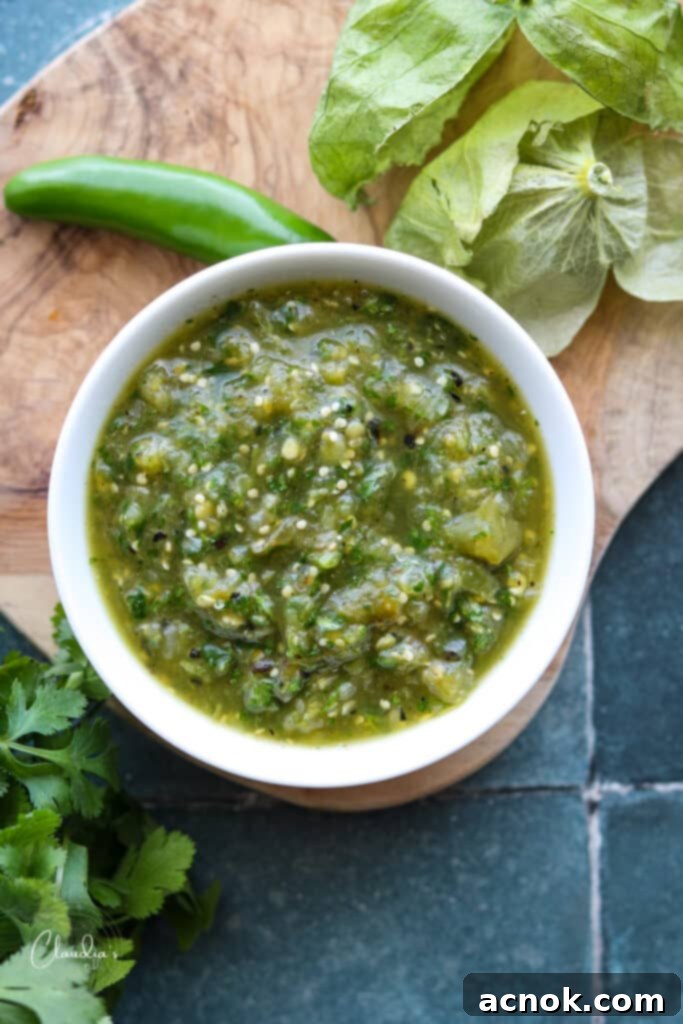
Storing and Make-Ahead Tips
One of the great advantages of making your own Roasted Tomatillo Salsa Verde is its excellent shelf life and how well it can be prepared in advance. This makes it perfect for meal prep or for having on hand whenever a salsa craving strikes.
- Refrigeration: Once prepared, transfer your salsa verde to an airtight container. It will keep beautifully in the refrigerator for up to 5-7 days. The flavors often meld and deepen even further after a day or two!
- Freezing: For longer storage, salsa verde freezes exceptionally well. Pour it into freezer-safe containers or even ice cube trays for individual portions. It can be stored in the freezer for up to 3 months. Thaw overnight in the refrigerator before serving. Stir well before using, as some separation might occur.
- Make-Ahead: Feel free to make a larger batch! This salsa is perfect for preparing on a weekend and enjoying throughout the week in various meals. It’s also an excellent homemade gift for friends and family who appreciate fresh, authentic flavors.
Frequently Asked Questions About Salsa Verde
Here are answers to some common questions you might have when making this delicious Roasted Tomatillo Salsa Verde:
- Can I use canned tomatillos for this recipe?
Yes, you can! However, canned tomatillos are already cooked, so you won’t be able to roast them to achieve that signature smoky flavor. If using canned, drain them well and proceed directly to the blending step with raw onion, garlic, and chiles. You might also want to lightly char the chiles on their own in a dry pan or under the broiler to add some smoky depth. The flavor will be different but still delicious.
- How can I adjust the heat level?
The heat comes primarily from the chiles. For a milder salsa, use fewer chiles (1-2) and remove all the seeds and white membranes before roasting. For a spicier salsa, use more chiles (3-4+) and leave some or all of the seeds intact. You can also mix chile types, like adding a less spicy poblano alongside a serrano for more nuanced flavor.
- What if my salsa is too watery?
This can happen if your tomatillos released a lot of liquid or if you added too much water when blending. To thicken it, you can return it to a saucepan and gently simmer over low heat, stirring occasionally, until some of the liquid evaporates. Be careful not to cook it down too much, as you want to preserve the fresh flavor.
- What if my salsa is too thick?
If your salsa is too thick for your liking, simply add a small amount of water or chicken broth, a tablespoon at a time, until you reach your desired consistency. Pulse briefly in the blender to combine.
- Can I use a regular pan instead of cast iron?
Yes, you can use a regular heavy-bottomed skillet. A non-stick pan might not achieve the same level of char, but it will still cook the vegetables. Just ensure it can withstand medium-high heat. The cast iron is preferred for its superior heat retention and ability to create a beautiful, even char.
- How do I safely handle hot chiles?
Chiles contain capsaicin, which can irritate skin and eyes. It’s highly recommended to wear gloves when handling and deseeding chiles. Avoid touching your face, especially your eyes, until you’ve thoroughly washed your hands with soap and water.
Enjoy the process of making this flavorful salsa, and don’t hesitate to experiment with the spice level and consistency to make it truly your own!
Enjoy!
If you tried this recipe, please help other readers by commenting below and sharing some stars! We 🫶🏼 appreciate you!
All content and photographs ©Claudia’s Table and claudiastable.com
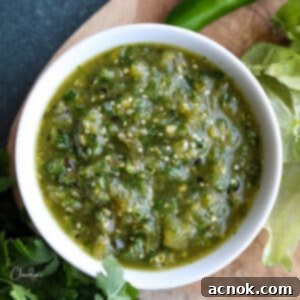
Roasted Tomatillo Salsa Verde
Ana | Claudia’s Table
April 3, 2024
Pin Recipe
Equipment
-
Food processor or blender
-
Cast iron pan (or heavy-bottomed skillet)
Ingredients
- 6 raw tomatillos husks removed, washed and dried.
- 1/4 of a small white onion peeled and cut into a wedge
- 2 garlic cloves peeled
- 1 cup fresh cilantro washed and dried
- 1-3 Serrano or Jalapeño chiles stems removed. (Seeds removed if you prefer a more mild salsa.)
- Olive oil or canola spray
- Salt
Instructions
-
Spray the cast iron pan with a tiny bit of oil.
-
Place the cast iron pan over medium heat on the stove.
-
Add the tomatillos, onion wedge, and whole chiles. You will start to see the ingredients char and the smell of roasting chiles in the air. Continue to rotate them every few minutes.
-
Note that the tomatillos, onions, and chiles will be par-cooked. They will be tender but not mushy.
-
Now it’s time to remove them from the heat source and pan.
-
Using a food processor or blender, add the roasted tomatillos, onion, Serrano chiles with the stems removed.
-
Add the fresh cilantro and fresh garlic cloves. Pulse until the salsa is a slightly chunky consistency.
-
You can add a little bit of water to thin it out if desired. Add salt to taste.
Nutrition
Nutritional information is calculated online and should be used as a guide.
All content and photographs ©Claudia’s Table and claudiastable.com
Explore More Delicious Recipes
- Pasta with Grilled Vegetables, Feta, and Lemon
- Grilled Asian Marinated Flank Steak
- Classic Homemade Chunky Blue Cheese Dressing
- 3-Ingredient Crispy Oven-Roasted Potatoes
- Grilled Peach Avocado Chicken Salad
